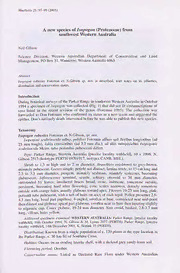
A new species of Isopogon (Proteaceae) from southwest Western Australia PDF
Preview A new species of Isopogon (Proteaceae) from southwest Western Australia
Miielleria 21:91-99 (2005) A new species of Isopogon (Proteaceae) from southwest Western Australia Neil Gibson Science Division, Western Australian Department of Conservation and Land Management, PO Box 51, Wanneroo, Western Australia 6065 Ahstnict Isopogon wbustiis Foreman cx N.Gibson sp. nov. is described, with notes on its affinities, distribution and conservation status. Introduction During botanical surveys of the Parker Range in southwest Western Australia in October 1994 a specimen of Isopogon was collected (Fig. 1) that did not fit circum.scriptions of taxa listed in the recent revision of the genus (Foreman 1995). The collection was forwarded to Don Foreman who confirmed its status as a new taxon and suggested the epithet. Don’s untimely death intervened before he was able to publish this new species. Taxonomy Isopogon rohustiis Foreman ex N.Gibson, sp. nov. Isopogoni sccibriuscnlo subsp. pnbflori Foreman affmis sed floribus longioribus (ad 25 mm longis), foliis crassioribus (ad 3.3 mm dia.); ad aliis subspeciebus Isopogonis scabriuscnki Meisn. tubo perianthii pubescenti differt. Type: Parker Range, Western Australia [precise locality withheld], 10 x 1996, N. Gibson 2513 (holotype PERTH 04701917, isotypes CANB, MEL). Shrub to 1.5 m high and to 2 m diameter. Branchlets red-brown to grey-brown, minutely pubescent. Leaves simple; petiole not distinct; lamina terete, to 15 em long and 2.5 to 3.3 mm diameter, pungent, minutely scabrous, minutely sericeous, becoming glabre.scent. Inflorescence terminal, se.ssilc, .solitary, obovoid to 38 mm diameter, surrounded by leaves; involucral bracts broad, ovate, imbricate, tomentose outside, persistent, becoming hard after flowering; cone scales narrower, densely tomentose outside with orange hairs, usually glabrous toward apex. Flowers 19-25 mm long, pink; perianth tube pubescent, with a tuft of hairs on apex of each lepal. Pollen presenter 2.6- 4.5 mm long; ba.sal part papillose, 4-angled, swollen at base, constricted near mid-point then dilated and globo.se; apical part glabrous, swollen near its base then tapering slightly to stigmatic cup. Cones globose, 19-24 mm diameter. Nuts ovoid, beaked, 2.8-3.7 mm long, villous, hairs yellow. Additional specimens examined: WESTERN AUSTRALIA: Parker Range, [precise locality withheldl, 16th October 1994, N. Gibson & M. Lyons 2077 (PERTH); Parker Range, [precise locality wilhheld[, 14th December 2001, K. Bcttink 35 (PERTH). Distribution: Known from a single population of c. 120 plants at the type location in the Parker Range, c. 50 km SE of Southern Cross. Habitat: Occurs on an eroding laterite shelf, with a skeletal grey sandy-loam soil. Flowering period: October. Conservation .status: Listed as Declared Rare Flora under Western Australian 98 Gibson Figure 1. The type of Isopogon rolmstus showing terminal inflorescenees on annual branches. Scale bar 10 cm. Isopogon 99 Table 1. Characters distinguishing Isopogon rohiisitis from the subspecies of Isopogon scahriiiscultis. Leaf width measured halfway between base and tip. Isopogon scahrittsculus Isopogon scabriusculus Isopogon scabriusculus Isopogon robustus subsp. scabriusculus subsp. stenophyllus subsp. pitbifloris Leaf type simple or lobed simple simple simple Leaf cross-section Oat terete terete terete Leaf width 2.1-3.8 mm 1.2-2.5 mm 1.2-2.5 mm 2.5-3.3 mm Flower length 12-15 mm 9-15 mm 11-16 mm 19-25 mm Perianth tube no no yes yes pubescent legislation. Meets criteria for listing as Critically Endangered under lUCN guidelines (lUCN 2001). Precise location details withheld for conservation reasons. The population occurs in ati area under threat frotn exploration and mining activity (Gibson & Lyons 1998). Etymology: The specific epithet is from the Latin word rohiistiis (robust), referring to the thick leaves and large flowers of this species. Notes: The new species is most closely related to Isopogon scahriiisciiliis Mcisn. but differs in having longer Hovvers and thicker terete leaves (Table 1). Of the three subspecies of /. sciibrinsculits the new taxon is most similar to I. scabriiiscnlns subsp. pitbifloris Foreman that also has a pubescent perianth tube. Acknowledgements Paul Wilson kindly provided encouragement and the latin diagnosis. Reference Foreman. D.B. (1995). Isopogon, Flora of Australia 16. 194-223. Gibson. N. and Lyons. M.N. (1998). Flora and vegetation of the Eastern Goldfields Ranges; Part 3. Parker Range. Journal of the Royal Society of Western Australia 81, 119-129. lUCN (2001). lUCN Red List Categories and Criteria: Version 3.1. lUCN Species Survival Commission. lUCN. Switzerland and Cambridge, UK.
